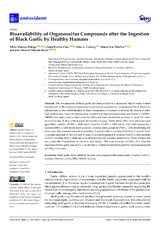Bioavailability of organosulfur compounds after the ingestion of black garlic by healthy humans
Autor
Moreno Ortega, Alicia
Pereira-Caro, Gema
Ludwig, Iziar A.
Motilva, María-José
Moreno-Rojas, José Manuel
Editor
MDPIFecha
2023Materia
Black garlicBioavailability
Human urine
Organosulfur compounds
Acetylcysteine
METS:
Mostrar el registro METSPREMIS:
Mostrar el registro PREMISMetadatos
Mostrar el registro completo del ítemResumen
The consumption of black garlic has been related to a decreased risk of many human diseases due to the presence of phytochemicals such as organosulfur compounds (OSCs). However, information on the metabolization of these compounds in humans is limited. By means of ultra high-performance liquid chromatography coupled with high-resolution mass spectrometry (UHPLC HRMS), this study aims to determine the OSCs and their metabolites excreted in urine 24 h after an acute intake of 20 g of black garlic by healthy humans. Thirty-three OSCs were identified and quantified, methiin (17,954 ± 6040 nmol), isoalliin (15,001 ± 9241 nmol), S-(2-carboxypropyl)-L cysteine (8804 ± 7220 nmol) and S-propyl-L-cysteine (deoxypropiin) (7035 ± 1392 nmol) being the main ones. Also detected were the metabolites N-acetyl-S-allyl-L-cysteine (NASAC), N-acetyl-S-allyl L-cysteine sulfoxide (NASACS) and N-acetyl-S-(2-carboxypropyl)-L-cysteine (NACPC), derived from S-allyl-L-cysteine (SAC), alliin and S-(2-carboxypropyl)-L-cysteine, respectively. These compounds are potentially N-acetylated in the liver and kidney. The total excretion of OSCs 24 h after the ingestion of black garlic was 64,312 ± 26,584 nmol. A tentative metabolic pathway has been proposed for OSCs in humans.

